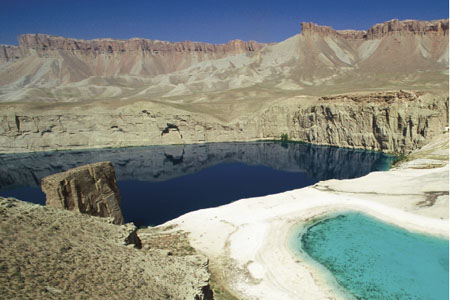
Abandoned Places
Issue 9 Jan / Feb 2005
It took 105,000 km, 2200 rolls of film, 320 hours of video and 920 days spent in the desert over five years. The result is a startling and stunning 372 page book entitled Deserts of the Earth. Michael Martin talks to Sarah Joseph about the epic adventure behind his latest project.
Michael Martin is a rare breed in that he is both geographer and photographer. With a Masters in Geography from Munich University he has been taking photos since he was 14. By the age of 17 he was gripped by deserts and began traveling to them.
“As a geographer I like the absence of vegetation, soil and people. You can see the geological structures perfectly. As a photographer the deserts are an eldorado of colour and form. As a traveller I love the challenge of crossing deserts. Even today it is still possible to have adventures.”
Martin is an experienced traveller. He spent 17 years photographing the people and landscape of Africa. Yet, still he was challenged by the deserts, although bureaucracy and political disturbances were more dangerous than nature. “The most difficult things were the political and criminal situations in some areas: land mines in Chad and Afghanistan or hijacking in Yemen are more dangerous than any snake or scorpion.”
His mode of transport was also precarious. Martin made the 105,000km journey with his travelling companion and project partner, Elke Wallner, on a single BMW motorbike. “The bike had a maximum range of 700km. Most of our space was taken up by film, camer equipment and materials. We had enough food and water for a few days thanks to some special equipment.” Needless to say, crossing a desert on one motorbike, with no back up vehicles, has its own intrinsic dangers and difficulties. Their spare tyre burst in the middle of war-torn Sudan. They were rescued by some smugglers who fixed the tyre with a needle and some rope. However, Martin feels that the bike also made them more accessible than a car would have and thus it allowed them to get closer to the people. Getting close to people is important to Martin, “If you photograph people you must give them the feeling that you are interested in them and not only in your photo. You must like the people; otherwise you will have a lot of problems.”
Yet many of Martin’s pictures are landscapes with no people, indeed deserts are named because of their abandoned status. The challenge was to get to areas to take the photos, “To get a great picture is mostly a question of getting to the area. Sometimes you have to struggle a lot to be on the perfect spot at the right time.” And if when they got to the spot the light was wrong, they would have to return to the same place, often more than once, until they felt they had the image they wanted.
Such dedication and passion for the project also extends to his feelings about the deserts themselves, “Deserts are extremely sensitive. Mankind should protect them. The reality though is that they are used for oil exploration, for nuclear dumping, for nuclear testing. We will lose some of the most interesting areas of our planet, if we do not stop this. Deserts need a status like Antarctica. Unfortunately the deserts cover so many different countries that I don’t really hold out much hope that they will be protected.”
Martin’s desire to increase people’s knowledge of the geographic sensitivity is also extended to the people. Many of the largest desert areas encompass little known parts of the Muslim world, and despite negative media their encounters were positive, “All in all we felt very welcome in all the Muslim countries we visited. We met so many different people, and everybody was so friendly. I feel the media presentation of Muslim countries is very unrealistic. People want to live peacefully with their families. Most of the people are very tolerant. I hope the relationship between Europe and Muslim countries develops in a good way.”
The people of the all the world’s deserts left a profound effect on Martin, as he says in the book, “The knowledge passed on from one generation to another, profound respect for the environment, an inner strength, and a firm belief in a solid set of values – these are the essential tools that enable the people to survive. They have an aura and a confidence that often exceeds anything that we Europeans are used to, and I have nothing but the deepest respect and admiration for them.”
His respect for the people and for the lands is obviously what has allowed Martin to create such a work. It is a rare glimpse, and stands as a record, of lands and of peoples who are undergoing immense and speedy change.
Bookmark this |
|
Add to DIGG |
|
Add to del.icio.us |
|
Stumble this |
|
Share on Facebook |
|
Share this |
|
Send to a Friend |
|
Link to this |
|
Printer Friendly |
|
Print in plain text |
|


Comments
0 Comments